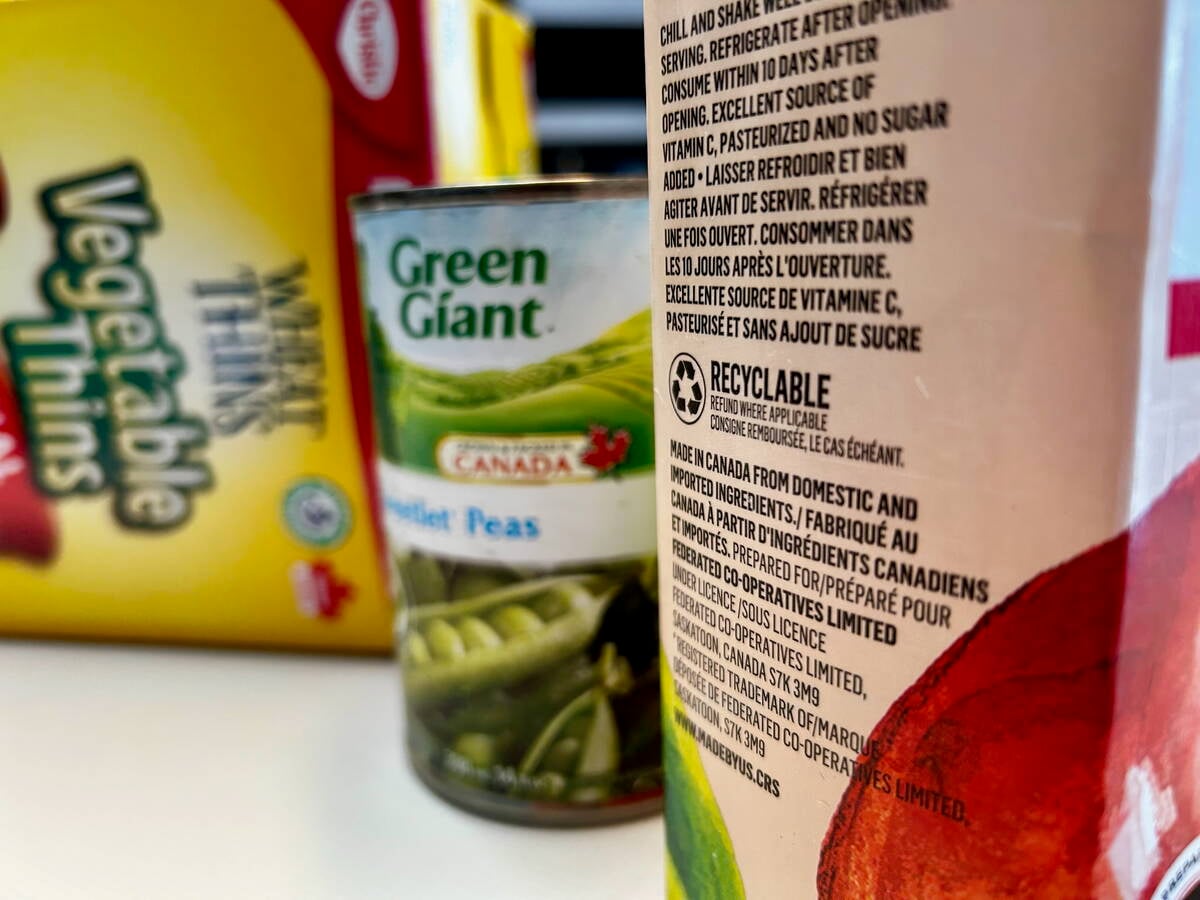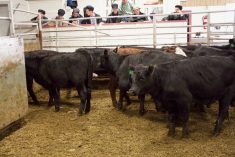Seven months ago, producers around Joe Bouchard’s farm near Fisher Branch figured their pastures might be dead.
“It was pretty grim here in July,” he said, recalling those dire days as the province, and Interlake in particular, were crippled by drought. “We started shipping older cows, cows that we knew were open. We pulled our bulls earlier than normal. We’ve shipped more cows than we normally do.”
It’s a story set on repeat in Bouchard’s area. Like many of his neighbours, Bouchard was forced to destock in order to preserve the core of his herd as forage and water both ran out. Farmers watched with some despair as pastures browned and crisped, while a ravenous grasshopper population mowed down the remaining greenery.
Read Also

Unclear food labels hinder Canada’s ‘buy local’ surge
“Maple-washing” on Canadian food packaging makes label claims hard to keep straight and hurts both farmers and consumers trying to buy Canadian, economist says.
But the concern went deeper than that. Pastures in the area had also started showing signs of cumulative damage. The area had seen abnormally dry conditions, although not as severe as in 2021, through the last four years.
New weed problems were cropping up, Bouchard noted, while stressed pastures were showing less resilience to poor weather. Late frost had killed patches of grass.
“The animals have been overgrazing just because there hasn’t been really any other option,” he said. “Hopefully the weather is turning in the right direction and we can get out of these bad habits.”
Why it matters: Producers will have to manage their recovery and cumulative pasture impact after last year’s drought handed down the worst, but not the only, recent hard grazing year.
As it would turn out, Bouchard’s pastures would hang on. Late-summer rains would lead to a surge in regrowth. Extended grazing would provide a much-needed reprieve. Heavy snow over the winter would give some hope that moisture conditions would not be so dire in 2022.
Despite that hopeful start however, experts warn that the bill will likely still come due this year.
The real drought penalty is felt the year after a drought, according to Ed Bork, Mattheis Chair in Rangeland Ecology and Management at the University of Alberta.
Producers who were not already managing for drought prior to last year are already facing a serious disadvantage, he said. Pastures without enough litter, for example, have a compromised water cycle and limited ability to keep soil cool.
“You get this drought in 2021 and people decide, ‘yeah, it’ll rain; it’ll rain, don’t worry about it,’ and then it doesn’t rain, and then you start to destock, but you’ve already grazed your pastures way harder than you should have,” he said. “You’ve compromised the amount of roots and where those roots are located. A lot of those plants have sacrificed their deep roots.”

Fast-forward to the next spring. Those plants now face the new season with reduced root mass and with less ability to access subsoil moisture, as well as the aftermath of reduced leaf mass during the drought, he argued.
“Their growth is going to be extraordinarily slow,” he warned.
Wait for it
Producers are trying to give pastures as much head start as possible before turnout, although a harsh winter, limited forage harvest from last year and even more limited affordable feed for sale have complicated those efforts.
Feed as a whole has handed down hard situations for producers, Bart Lardner of the University of Saskatchewan and Western Beef Development Centre said.
For producers who can manage it, however, he said, patience will go a long way in long-term pasture recovery.
“Get out there and assess your pasture,” he said. “Can you get away with allowing a full year rest on some of these areas?… You can’t obviously keep animals off all your pasture resources, but have a long-term plan, a five-year plan or something, where you rotate through and allow rest on those areas.”
He urged producers to look for novel feeds, “rolling up every bit of fibre you can find,” to bridge the gap before pastures are ready.
It is advice that producers have likely heard before.
Manitoba Agriculture staff have consistently urged producers to avoid premature turnout due to poor growing conditions in recent springs.
Shawn Cabak, livestock specialist with the province, suggested a pasture should have four to six inches of growth before cattle start to graze.
“If they’ve been overgrazed, that means they’re weaker. They will not be as productive, so we have to give them a chance to recover,” he said.
Premature turnout also risks cattle nutrition, he added, since there is limited growth for the animal to meet its needs.
Rotational grazing, likewise, is on Cabak’s suggested practice list for farmers following the drought. A short graze, followed by rest, would allow plants to build better reserves than having regrowth continually clipped, he said.
Manitoba Agriculture estimates that rotational grazing might increase production by up to 50 per cent.
“That can be splitting your pasture into four to five paddocks and rotating cattle around,” he said.
Bouchard, for his part, expects to delay turnout as long as he can, “without running our feed supply down to nothing.”
He hopes to hold back until late May or early June.
He is, he acknowledged, more fortunate than some.
Earlier this year, the Manitoba Beef Producers noted that harsh winter conditions had exacerbated feed shortages, while little additional feed was coming onto the market. What was coming on sale, president Tyler Fulton noted at the time, was expensive.
The economic realities are “always a concern,” Cabak acknowledged. “When we feed the cows for six to seven months all winter, we’re tired of looking at them by the time the end of May rolls around. We just want to get them out to pasture.”
At the same time, he argued, every day of premature turnout can cost the producer up to three days of grazing come fall.
Annuals
Annuals, and winter cereals in particular, may also have a role in keeping cattle off the pasture until it’s ready, he noted.
“Seed that with a spring cereal, so oats or barley. Seed that together and then that can give you grazing early in the spring,” he said. “Once you get five to six inches of growth, you can graze it, take the cattle off; you rotate them; you let it regrow. You can graze that all through the season. You don’t have to worry about the winter cereal going to head.”
Lardner echoed that advice.
It’s an avenue that a number of producers have already turned to. Last fall, Manitoba Agriculture noted interest in winter cereals from producers hedging their bets on forage.
The sacrifice play
A sacrifice pasture might also be in the cards for Bouchard, the farmer noted.
The concept of a sacrifice pasture, a small area where cattle are purposefully turned out early, has also been a repeat suggestion in Manitoba Agriculture’s tool box.
A properly managed sacrifice pasture will then be given a longer rest period to make up for the early stress, Cabak said.
“The cattle can be supplemented on this paddock until the rest of the pasture is optimal for grazing,” he said, noting that the practice gets cattle out of a winter feeding environment and into a cleaner, larger area that is less stressful for cows and calves.
Bork however, is less than fond of the idea.
“These pastures are hurting already,” he said.
“The damage that you do to that pasture, and when I say damage, I’m not talking about how big are the roots on these plants, what kind of leaf area and meristems are left, I’m talking about maybe even the potential for soil erosion, for weed invasion, noxious weed invasion, you just set yourself up for a world of hurt,” he added.
That damage may take years to recover, Bork argued, particularly if the area is native pasture.
He prefers the option of grazing early-seeded annual crops, he said.
He acknowledged, however, that the farmer’s ability to do that will depend on weather, while the commodity price of annual crops may make grazing “a hard pill to swallow.”
The extra mile
While Mother Nature provides, Cabak also said this might be the year to give Mother Nature a little help.
Fertilizer could help, he said, although producers would have to carefully consider the cost, considering the current price of inputs.
“The economics are going to play into that, but even providing some nitrogen on a predominantly grass pasture will increase your overall grass and forage production,” he said.
Legumes should also be in the mix, for producers seeding down pasture, he stressed, along with productive grasses like meadow brome, orchardgrass or timothy. Mixes with about 50 per cent legumes will allow the producer to dodge that nitrogen input cost.
It does not necessarily have to be alfalfa, which comes with bloat risk, he added. Cabak pointed to legumes such as bird’s-foot trefoil, which are not associated with bloat.
Producers with weed issues from cumulative stress will also have to gauge their response, Lardner said.
Pastures with 30 per cent or less productive species should consider an overhaul of that pasture’s composition.
“Which is extremely expensive,” he said.
Producers may, however, see sod seeding as a way to revamp a struggling pasture, he said.
Looking ahead
Manitoba’s winter, in general, has been snowy, with many regions reporting a metre and a half or more of snowfall. The melt, meanwhile, has been gradual — a mixed blessing as snowdrifts have been slow to disappear, but that gives hope that water may be flowing down rather than off the field.
Bouchard is under no illusions that this year will be easy, however, in the aftermath of 2021.
His herd numbers will be purposefully tight this year in an effort to reduce the demand for feed, he said, on top of a hopefully delayed turnout, sacrifice pasture or supplemental annuals for grazing.
As well as drought stress, he noted, producers in his area are concerned about grasshoppers, considering the number of eggs that were likely laid last year.
“We’re not going to be carrying any extra cattle,” he said. “They’re going to need a live calf to go out on pasture.”
Both Lardner and Bork, meanwhile, are urging producers to get a long-term drought plan in place, if they haven’t had one in the past.
It has, they argue, allowed producers in the drier regions of their provinces — all arguably more familiar with drought than Manitoba — much-needed resilience when the taps turn off.
“Yeah, it’s tough, but a lot of those wise ranchers in the south part of our province, they have a year’s worth of grazing banked on their native rangeland,” Lardner noted.
















